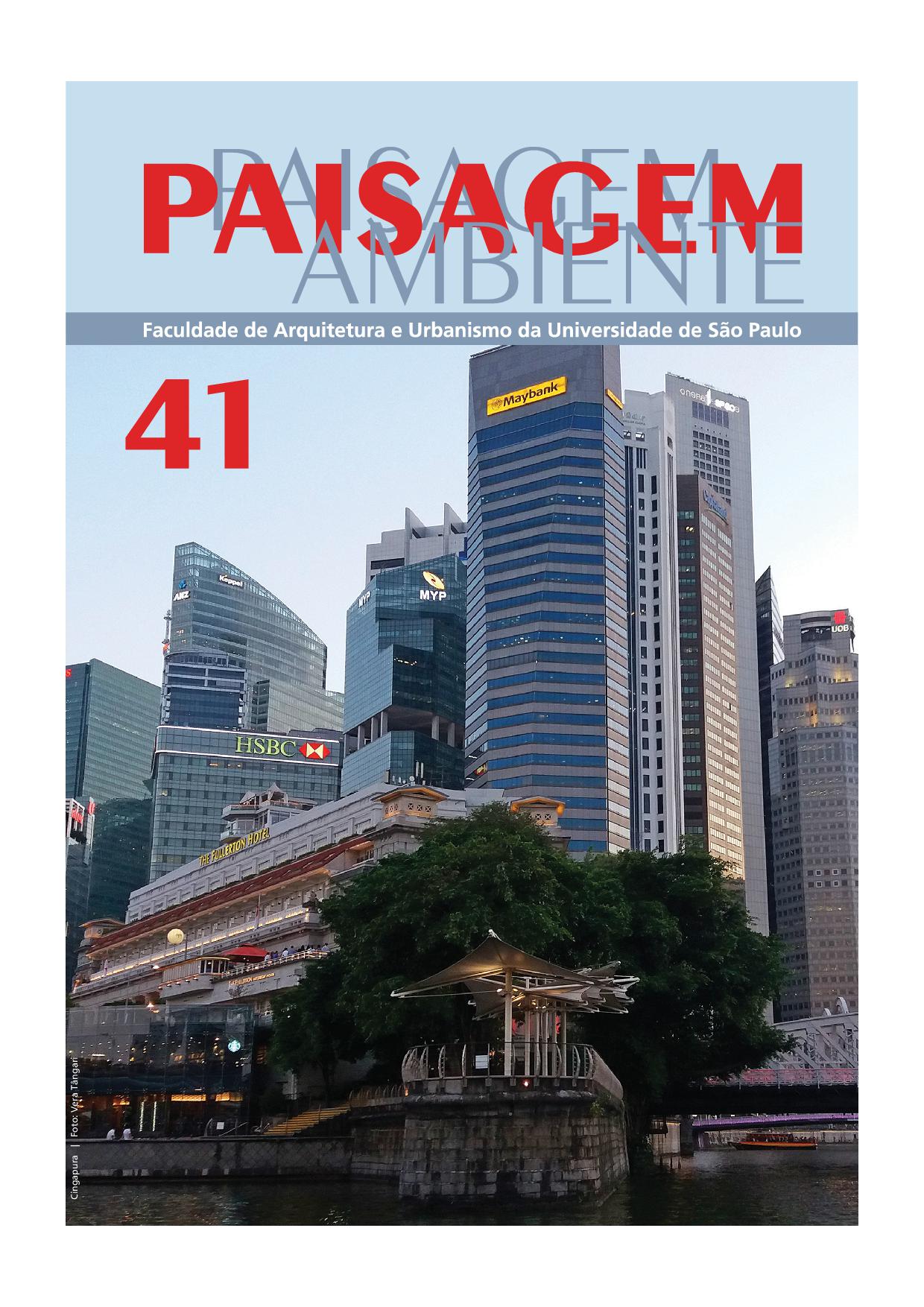Shape and function in the urban design of squares
Jacob Javits Plaza, New York
DOI:
https://doi.org/10.11606/issn.2359-5361.v0i41p35-55Keywords:
Public space, Urban landscape, Shap, Function, Design lineAbstract
Within the different fields of architects, designers, landscape designers and urbanists, the relationship between shape and function of spaces, with the subsequent balance or prevalence of either one of the terms, has been explored and linked to definitions of modern and postmodern. The present article uses one of the
elements of urban landscape morphology, the construction-free spaces, to make a comparison between the
field of landscape architecture and the field of sculptural art, in order to discuss how the relationship between shape and function can influence the adoption of spaces for public use. This research case study is the Jacob Javits Plaza, in New York, and its urban landscape transforming process after different designs have
been implanted since 1967. The methodological procedures included reading and formal description of the
composition lines of the interventions from the redesigning of the proposals carried out at the plaza, survey
and analysis of secondary data. These were composed of texts about the square and observations made by
the designs’ authors, as well as identification of the design lines according to connections established with
the concepts stated by Rosalind Krauss, Anthony Vidler, Silvio Macedo, and Franco Panzini. The results show
that the equilibrium or imbalance relationship between shape and function in the design of construction-free
spaces, a consequence of choosing a modern or postmodern design line, has a direct impact on the semantic
appraisal of the urban landscape composition and, consequently, can influence and determine the collective
identification and adoption of public spaces by the population.
Downloads
References
BUSINESS DICTIONARY. Portal do site Business Dictionary, 2018. Disponível em: http://www.businessdictionary.com/definition/. Acesso em: 17 fev. 2018.
CALLIARI, Mauro. Espaço público e urbanidade em São Paulo. São Paulo, Bei Comunicação, 2016.
GREEN, Jared. Jacob Javits Plaza gets a redesign with recovery funds In: ASLA, 03 fev. 2010. Disponível em: https://dirt.asla.org/2010/02/03/jacob-javits-plaza-gets-a-redesign-with-recovery-funds/. Acesso em: 14 dez. 2016.
GSA – US General Services Administration. Jacob Javits Federal Building & Janes Watson Tribunal de Comércio Internacional, New York, 2016. Disponível em: https://www.gsa.gov/portal/ext/html/site/hb/category/25431/actionParameter/ exploreByBuilding/buildingId/1267. Acesso em: 27 dez. 2016.
KRAUSS, Rosalind. A escultura no campo ampliado. Gávea - revista do Curso de Especialização em História da Arte e Arquitetura no Brasil, Rio de Janeiro, PUC-RIO, 1984, p. 87-93. Disponível em: https://monoskop.org/images/b/bc/Krauss_Rosalind_1979_2008_A_escultura_no_ campo_ampliado.pdf. Acesso em: 15 dez. 2016.
LOW, Setha. Jacob Javits Plaza: Reconsidering Intentions, 2007. Disponível em: https://archidose.blogspot.com.br/2007/05/jacob-javits-plaza-reconsidering.html. Acesso em: 14 fev. 2018.
MACEDO, Silvio Soares. Quadro do Paisagismo no Brasil. São Paulo, [Coleção Quapá, V. 1], 1999.
MACEDO, Silvio Soares. Paisagismo Brasileiro na Virada do Século: 1990-2010. São Paulo, Editora da Universidade de São Paulo; Campinas, Editora da Unicamp, 2012.
MILLER, KRISTINE F. Designs on the Public: The Private Lives of New York’s Public Spaces. University of Minnesota Press, 2007.
PANZINI, Franco. Projetar a natureza: arquitetura da paisagem e dos jardins desde as origens até a época contemporânea. São Paulo, Editora Senac, 2013.
POINT 2HOMES. Civic Center Demographics, Portal do site Point 2Homes, 2018. Disponível em: https://www.point2homes.com/US/Neighborhood/NY/Manhattan/Civic-Center -Demographics.html. Acesso em: 17 fev.2018.
PSTREETSTUDIO. The Pstreet Blog, 2016. Disponível em: http://www.pstreetstudio.com/uploads/5/8/6/1/58616737/6615855.jpg?370. Acesso em: 05 jan. 2017.
ROBBA, Fabio; MACEDO, Silvio Soares. Praças Brasileiras – Public squares in Brazil. São Paulo, Imprensa Oficial do Estado, 2002. [Coleção Quapá].
SCHWARTZ, Martha. Jacob Javitz Plaza. In: Site do escritório Martha Schwartz Partners, 1997. Disponível em: http://www.marthaschwartz.com/. Acesso em: 22 dez. 2016.
SENIE. Harriet F. A polêmica em torno de Tilted Arc: um precedente perigoso? (tradução: Milton Machado), 2002. Programa de Pós-Graduação em Artes Visuais – EBA – UFRJ. Disponível em: www.ppgav.eba.ufrj.br/wpcontent/uploads/2012/01/ae17_Harriet_Senie.pdf. Acesso em 23 dez. 2016.
TATE. Glossary, United Kingdom, 2016. Disponível em: http://www.tate.org.uk/learn/online-resources/glossary/. Acesso em: 27 dez. 2016.
VALKENBURGH, Michael Van. Jacob Javits Plaza. 2013. Disponível em: http://www.mvvainc.com/project.php?id=15&c=plazas_and_streetscapes. Acesso em 27 dez. 2016.
VERCELLONI, Matteo; VERCELLONI, Virgilio. Inventing the garden. Los Angeles, Getty Publications, 2010.
VIDLER, Anthony. O campo ampliado da arquitetura, 2005. In: SYKES, A. Krista. O campo ampliado da arquitetura: antologia teórica, 1993-2009. São Paulo, Cosac Naify, 2013, p. 243-251.
YIN, Robert K. Estudo de caso: planejamento e método. Porto Alegre, Bookman, 2010.
ZOLA – Zoning & Land Use. NYC Planning, The City of New York, 2017. Disponível em: http://maps.nyc.gov/doitt/nycitymap/template.jsp?applicationName=ZOLA. Acesso em 05 jan. 2017.
Downloads
Published
Issue
Section
License

A revista Paisagem e Ambiente: ensaios tem licença Creative Commons
Creative Commons - Atribuição-NãoComercial-CompartilhaIgual 4.0 Internacional
DIADORIM - Diretório de Políticas Editoriais
O detentor dos direitos autorais é o autor do artigo. A revista exige apenas o ineditismo na publicação do artigo. O autor tem do direito de divulgar seu artigo conforme sua conveniência.


